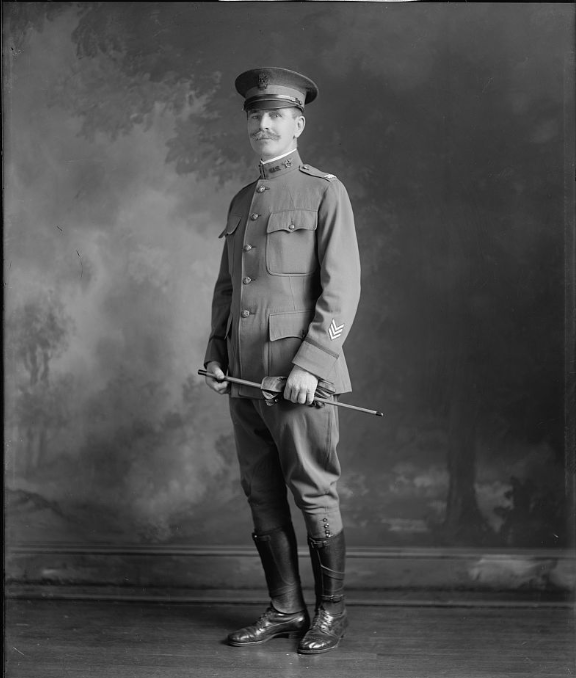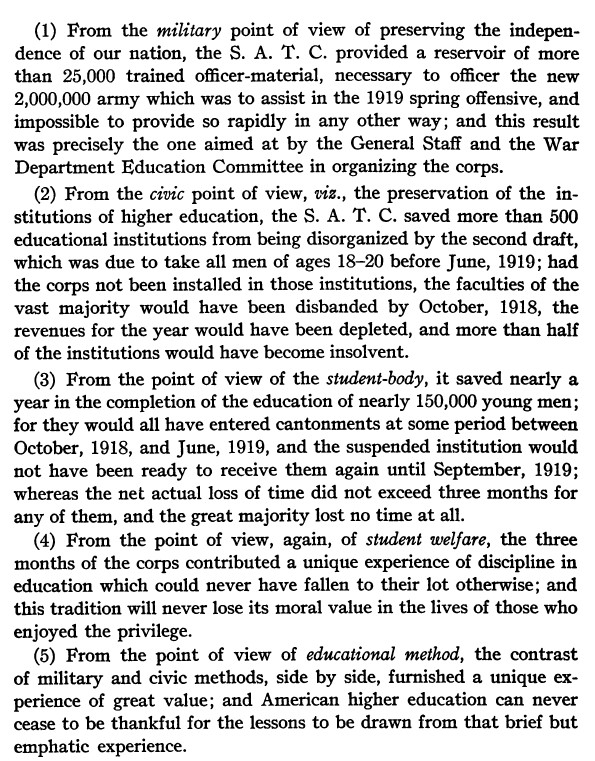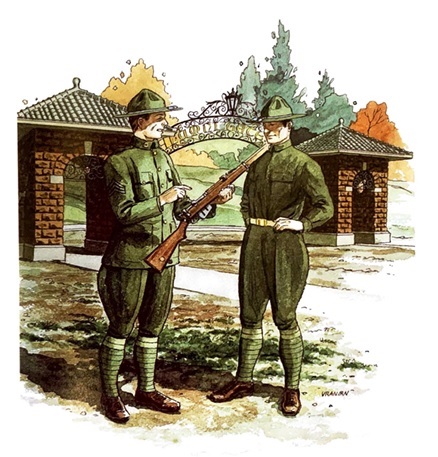The Armistice on November 11, 1918 cut short the SATC program. By December 21, 1918, all members and officers of the SATC were discharged or transferred to other units. The Reserve Officer’s Training Corps, which was active prior to the war, was reinstated by the Committee on Education and Special Training (CEST) on November 23, 1918. The members of the CEST either resigned their commissions from the military or transferred to other units and posts.1
In the immediate aftermath of SATC demobilization, a few reports and works about the SATC were published. In 1919, the CEST’s Advisory Board published Committee on Education and Special Training: A Review Of Its Work During 1918. This 144 page book was a detailed report of the Committee and its work during the war and provides a broad overview of the program only going into detail on the high level administration of the program. That same year, Parke Rexford Kolbe, President of the University of Akron published The Colleges in War Time and After: A Contemporary Account of the Effect of the War Upon Higher Education in America. This work focused on the how higher education changed, adapted, and evolved as a result of the the First World War. Kolbe devotes a chapter to the SATC, but like the CEST report, only provides a general overview of the program.2
Interpreting the SATC
Aside from these initial reports, very little was written about the SATC. However, in November 1922, an excerpt from a report written by J.H. Wigmore, Dean of Northwestern University’s Law School, was published in the Bulletin of the American Association of University Professors. Wigmore’s writing was the first work to provide an interpretation about the effectiveness of the program. The excerpt focused on the SATC and argued that the program was a “complete success in producing two result vital to military and to civic interests, and it was invaluable in its contribution to three other important elements.”3 Wigmore had a vested interest in ensuring a positive legacy for the SATC. During the war, Wigmore served on the Committee of Education and Special Education as a Lt. Colonel from the the Judge Advocate General’s Office.4


Wigmore’s report provided an extremely positive outlook on the SATC, but some colleges did not share Wigmore’s view. A post-war report written by Theodorick Pryor Campbell, Dean of the General Faculty at Virginia Polytechnic Institute, disagreed with Wigmore’s analysis. While Campbell conceded that the SATC bolstered the college’s enrollment and the positive effect of military training, he was deeply critical about the way the Committee on Education and Safety ran the SATC. Campbell wrote that this was a result of “the unsettled condition superinduced [sic] by the establishment of the S.A.T.C., the slowness of induction, the irregularity of induction, . . . [and] the varied and different rulings of the Committee as to who might be inducted.”6
The SATC in the 21st Century
After the initial post-war reports, very little was written about the SATC. However, some colleges and universities, such as Virginia Tech, Johns Hopkins, Swarthmore, and Texas Christian University, who had SATC units have created webpages about the SATC, but these mostly consist of a brief mention of the program on the campus with one or two photographs or documents.
In 1998, Henry Downing Temple published a six volume history of the corps of cadets at Virginia Polytechnic Institute from 1872 to 1934. Entitled The Bugle’s Echo: A Chronology of Cadet Life at the Military College at Blacksburg, Virginia, The Virginia Polytechnic Institute, the second volume covers 1912-1920 and Temple briefly covers the SATC unit at VPI. While an excellent source for understanding the history of the VPI unit and how it interacted with the corps of cadets, faculty, and administration, The Bugle’s Echo does not examine the program as a whole.

Over the past fifteen years, the SATC has received some more in depth attention from scholars, though it is mostly brief mentions or a general overview of the program. Lynn Rainville’s 2018 work Virginia and the Great War: Mobilization, Supply and Combat 1914-1919 and Alexander F. Barnes and Peter L. Belmonte’s 2022 work United States Army Depot Brigades in World War I are the two most recent books that discuss the SATC. Rainville briefly mentions the SATC, but makes several incorrect statements about the program. For example, she includes a picture that supposedly shows the UVA SATC unit in early March 1918, even though the program was not officially adopted until late June 1918.8 Barnes and Belmonte go into more depth than Rainville, dedicating a chapter to examine the SATC. However, this chapter provides a general overview of the program and focuses on institutions in the Northeast and Midwest.
In 2008, Michael J. Faughnan, a PhD candidate at William & Mary’s School of Education, wrote a dissertation about the SATC. Faughnan went into more depth than Rainville and Barnes and Belmonte, and tackled some of the issues plaguing the SATC, mainly the trouble getting the proper supplies and staffing. However, the focus of his dissertation was analyzing “the implementation and impact of the SATC [at] the College of William and Mary and the University of Virginia.”9 Faughnan centers his analysis on the Board of Visitors, Presidents, and military commanders at each college and contrasts how each institution handled the various aspects of the SATC including the relationship between the military and college faculty and administration, receiving equipment, academic issues and the Spanish Flu.
Notes:
- The Advisory Board, Committee on Education and Special Training. A Review of Its Works during 1918 (Washington, 1919), 33, https://catalog.hathitrust.org/Record/000488027.
- The Advisory Board, Committee on Education and Special Training. A Review of Its Works during 1918 (Washington, 1919), https://catalog.hathitrust.org/Record/000488027; Parke Rexford Kolbe, The Colleges in War Time and After: A Contemporary Account of the Effect of the War Upon Higher Education in America (New York, London, D. Appleton, 1919), http://archive.org/details/cu31924027888555.
- J. H. Wigmore, “The Students’ Army Training Corps,” Bulletin of the American Association of University Professors (1915-1955) 8, no. 7 (1922): 60, https://doi.org/10.2307/40217179.
- “John Henry Wigmore | We’ll See Them Through,” accessed December 23, 2022, https://sites.northwestern.edu/plrcwwi/john-henry-wigmore/; The Advisory Board, Committee on Education and Special Training. A Review of Its Works during 1918 (Washington, 1919), 12, https://catalog.hathitrust.org/Record/000488027.
- J. H. Wigmore, “The Students’ Army Training Corps,” Bulletin of the American Association of University Professors (1915-1955) 8, no. 7 (1922): 61, https://doi.org/10.2307/40217179.
- Report of the Students’ Army Training Corps Virginia Polytechnic Institute Blacksburg, Virginia From October 1st to December 20th, 1918, 4, Box 3, Folder 8, Records of the Dean of the College, Theodorick Pryor Campbell, RG 11/1, Special Collections and University Archives, Virginia Tech, Blacksburg, VA.
- Harry Downing Temple, The Bugle’s Echo: A Chronology of Cadet Life at the Military College at Blacksburg, Virginia, The Virginia Polytechnic Institute, vol. III (1912-1920) (Blacksburg, VA: The Virginia Tech Corps of Cadets, Inc., 1998), 2137.
- Lynn Rainville, Virginia and the Great War: Mobilization, Supply and Combat, 1914-1919 (Jefferson, North Carolina: McFarland, 2018), 51, https://search.ebscohost.com/login.aspx?direct=true&AuthType=cookie,ip,shib&db=nlebk&AN=1712742&site=ehost-live&scope=site&custid=s8863137.
- Michael J. Faughnan, “You’re in the Army Now: The Students’ Army Training Corps at Selected Virginia Universities in 1918” (Ph.D diss., The College of William and Mary), 4, https://www.proquest.com/docview/304445751/abstract/D4CBC5397CC94EE1PQ/1.
Further Reading:
Lynn Rainville, Virginia and the Great War: Mobilization, Supply and Combat 1914-1919 (Jefferson, North Carolina: McFarland & Company, Inc., Publishers, 2018).
Alexander F. Barnes and Peter L. Belmonte, United States Army Depot Brigades in World War I (Jefferson, North Carolina: McFarland & Company, Inc., Publishers, 2022).